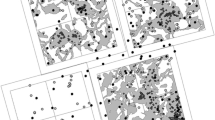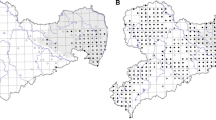Abstract
Changes in the forest management practices have strongly influenced the distribution of species inhabiting old-growth forests. The epiphytic woodland lichen Lobaria pulmonaria is frequently used as a model species to study the factors affecting the population biology of lichens. We sampled 252 L. pulmonaria individuals from 12 populations representing three woodland types differing in their ecological continuity and management intensity in Estonia. We used eight mycobiont-specific microsatellite loci to quantify genetic diversity among the populations. We calculated the Sørensen distance to estimate genetic dissimilarity among individuals within populations. We revealed that L. pulmonaria populations have significantly higher genetic diversity in old-growth forests than in managed forests and wooded meadows. We detected a significant woodland-type-specific pattern of genetic dissimilarity among neighbouring L. pulmonaria individuals, which suggests that in wooded meadows and managed forests dominating is vegetative reproduction. The vegetative dispersal distance between the host trees of L. pulmonaria was found to be only 15–30 m. Genetic dissimilarity among individuals was also dependent on tree species and trunk diameter. Lobaria pulmonaria populations in managed forests included less juveniles compared to old-growth forests and wooded meadows, indicating that forest management influences life stage structure within populations. We conclude that as intensive stand management reduces the genetic diversity of threatened species in woodland habitats, particular attention should be paid to the preservation of remnant populations in old-growth habitats. Within managed habitats, conservation management should target on maintenance of the stand’s structural diversity and availability of potential host trees.





Similar content being viewed by others
Abbreviations
- NE:
-
Northeast
- SW:
-
Southwest
References
Adermann V (2008) Estonian forests 2007. The estimation of forest sources by statistical sampling methodology. Metsakaitse- ja Metsauuenduskeskus, Tallinn
Andersson L, Appelqvist T (1987) Lobaria pulmonaria and Gyalecta ulmi as indicators of deciduous woodland with high nature qualities. Svensk Bot Tidskr 81:185–194
Andersson L, Martverk R, Külvik M et al (2003) Woodland key habitat inventory in Estonia 1999–2002. Regio Publishing, Tartu
Arnaud-Haond S, Belkhir K (2007) GENCLONE: a computer program to analyse genotypic data, test for clonality and describe spatial clonal organization. Mol Ecol Notes 7:15–17
Asplund J, Gauslaa Y (2008) Mollusc grazing limits growth and early development of the old forest lichen Lobaria pulmonaria in broadleaved deciduous forests. Oecologia 155:93–99
Belinchón R, Martínez I, Otálora MAG et al (2009) Fragment quality and matrix affect epiphytic performance in a Mediterranean forest landscape. Am J Bot 96:1974–1982
Büdel B, Scheidegger C (2008) Thallus morphology and anatomy. In: Nash TH (ed) Lichen biology. University Press, Cambridge, pp 40–68
Campbell J, Fredeen AL (2004) Lobaria pulmonaria abundance as an indicator of macrolichen diversity in Interior Cedar-Hemlock forests of east-central British Columbia. Can J Bot 82:970–982
Carlsson R, Nilsson K (2009) Status of the red-listed lichen Lobaria pulmonaria on the Åland Islands, SW Finland. Ann Bot Fennici 46:549–554
Edman M, Eriksson A-M, Villard M-A (2008) Effects of selection cutting on the abundance and fertility of indicator lichens Lobaria pulmonaria and Lobaria quercizans. J Appl Ecol 45:26–33
Etverk I, Sein H (1995) Forests and their management. In: Raukas A (ed) Estonian nature. Valgus and Eesti Entsüklopeediakirjastus, Tallinn, pp 402–416
Frankham R, Ballou JD, Briscoe DA (2002) Introduction to conservation genetics. Cambridge University Press, Cambridge
Gaggiotti OE (1996) Population genetic models of source–sink metapopulations. Theor Pop Biol 50:178–208
Gauslaa Y (1985) The ecology of Lobarion pulmonariae and Parmelion caperatae in Quercus dominated forests in south-west Norway. Lichenologist 17:117–140
Gauslaa Y, Lie M, Solhaug KA, Ohlson M (2006) Growth and ecophysiological acclimation of the foliose lichen Lobaria pulmonaria in forests with contrasting light climates. Oecologia 147:406–416
Gu WD, Kuusinen M, Konttinen T et al (2001) Spatial pattern in the occurrence of the lichen Lobaria pulmonaria in managed and virgin boreal forests. Ecography 24:139–150
Hartl DL, Clark AG (1997) Principles of population genetics. Sinauer Associates, Sunderland
James PW, Hawksworth DL, Rose F (1977) Lichen communities in the British Isles: a preliminary conspectus. In: Seaward MRD (ed) Lichen ecology. Academic, London, pp 295–413
Jüriado I, Liira J (2009) Distribution and habitat ecology of the threatened forest lichen Lobaria pulmonaria in Estonia. Folia Cryptog Estonica 46:55–65
Jüriado I, Liira J (2010) Threatened forest lichen Lobaria pulmonaria—its past, present and future in Estonia. For Stud 53:15–24
Kalwij JM, Wagner HH, Scheidegger C (2005) Effects of stand-level disturbance events on the spatial distribution of a lichen indicator of forest conservation value. Ecol Appl 15:2015–2024
Kohv K, Liira J (2005) Anthropogenic disturbances, structural changes and indicators in the boreal forest. Scan J For Res 20:122–134
Kukk T, Kull K (1997) Wooded meadows. Estonia Marit 2:1–249
Kukk T, Sammul M (2006) Area of seminatural Natura 2000 habitat types in Estonia. In: Sammul M (ed) Year-book of the Estonian Naturalists’ Society. Estonian Naturalists’ Society, Tartu, pp 114–158
Laasimer L (1965) Vegetation of the Estonian S.S.R. Valgus, Tallinn
Laasimer L, Masing V (1995) Flora and plant cover. In: Raukas A (ed) Estonian nature. Valgus and Eesti Entsüklopeediakirjastus, Tallinn, pp 364–401
Leppik E, Jüriado I (2008) Factors important for epiphytic lichen communities in wooded meadows of Estonia. Folia Cryptog Estonica 44:75–87
Leppik E, Jüriado I, Liira J (2011) Changes in stand structure due to the cessation of traditional land use in wooded meadows impoverish epiphytic lichen communities. Lichenologist 43:257–274
Liira J, Sepp T (2009) Indicators of structural and habitat natural quality in boreo-nemoral forests along the management gradient. Ann Bot Fennici 46:308–325
McCune B, Mefford MJ (1999) PC-ORD. Multivariate analysis of ecological data, version 4. MjM Software Design, Gleneden Beach
Nascimbene J, Caniglia G, Nicli M et al (2006) Populations of Lobaria pulmonaria (L.) Hoffm. in the Cansiglio Regional Forest (Veneto, Pre-Alps, north-east Italy): distribution, diversity and conservation issues. Plant Biosyst 140:34–42
Nascimbene J, Brunialti G, Ravera S et al (2010) Testing Lobaria pulmonaria (L.) Hoffm. as an indicator of lichen conservation importance of Italian forests. Ecol Indicat 10:353–360
Nilsson S, Arup U, Baranowski R et al (1995) Tree-dependent lichens and beetles as indicators in conservation forests. Conserv Biol 9:1208–1215
Öckinger E, Nilsson SG (2010) Local population extinction and vitality of an epiphytic lichen in fragmented old-growth forest. Ecology 91:2100–2109
Öckinger E, Niklasson M, Nilsson SG (2005) Is local distribution of the epiphytic lichen Lobaria pulmonaria limited by dispersal capacity or habitat quality? Biodiv Conserv 14:759–773
Otálora MAG, Martínez I, Belinchón R et al (2011) Remnant fragments preserve genetic diversity of the old forest lichen Lobaria pulmonaria in a fragmented Mediterranean mountain forest. Biodivers Conserv. doi:10.1007/s10531-011-0025-0
Päretel M, Helm A, Roosaluste E, Zobel M (2007) Biological diversity of Estonian semi-natural grassland ecosystems. In: Punning J-M (ed) Problems of contemporary environmental studies, vol 10. Tallinna Ülikooli Ökoloogia Instituut, Tallinn, pp 223–302
Peakall R, Smouse PE (2005) GenAlEx 6: genetic analysis in excel. Population genetic software for teaching and research. The Australian National University, Canberra
Richardson DHS, Cameron RP (2004) Cyanolichens: their response to pollution and possible management strategies for their conservation in northeastern North America. Northeast Nat 11:1–22
Riiali A, Penttinen A, Kuusinen M (2001) Bayesian mapping of lichens growing on trees. Biom J 43:717–736
Rose F (1976) Lichenological indicators of age and environmental continuity in woodlands. In: Brown DH, Hawksworth DL, Bailey RH (eds) Lichenology: progress and problems. Academic, London, pp 279–307
Scheidegger C (1995) Early development of transplanted isidioid soredia of Lobaria pulmonaria in an endangered population. Lichenologist 27:361–374
Scheidegger C, Goward T (2002) Monitoring lichens for conservation: red lists and conservation action plans. In: Nimis PL, Scheidegger C, Wolseley PA (eds) Monitoring with lichens—monitoring lichens, Nato Science Series. IV. Earth and environmental sciences. Kluwer Academic Publishers, Dordrecht, pp 163–181
Scheidegger C, Werth S (2009) Conservation strategies for lichens: insights from population biology. Fungal Biol Rev 23:55–66
Scheidegger C, Frey B, Zoller S (1995) Transplantation of symbiotic propagules and thallus fragments: methods for the conservation of threatened epiphytic lichen populations. Mitteilungen der Eidgenössishen Forschungsanstalt für Wald, Schnee und Landschaft 70:41–62
Scheidegger C, Frey B, Walser J C (1998) Reintroduction and augmentation of populations of the endangered Lobaria pulmonaria: methods and concepts. In: Kondratyuk SJ, Coppins B (eds) Lobarion lichens as indicators of the primeval forests of the Eastern Carpathians (Darwin International Workshop, 25–30 May 1998, Kostrino, Ukraine). Phytosociocentre, Kiev, pp 33–52
StatSoft Inc (2005) Statistica for Windows, ver 8.1. StatSoft, Inc, Tulsa
Wagner HH, Werth S, Kalwij JM et al (2006) Modelling forest recolonization by an epiphytic lichen using a landscape genetic approach. Landsc Ecol 21:849–865
Walser J-C (2004) Molecular evidence for limited dispersal of vegetative propagules in the epiphytic lichen Lobaria pulmonaria. Am J Bot 91:1273–1276
Walser J-C, Sperisen C, Soliva M et al (2003) Fungus-specific microsatellite primers of lichens: application for the assessment of genetic variation on different spatial scales in Lobaria pulmonaria. Fungal Genet Biol 40:72–82
Walser J-C, Gugerli F, Holderegger R et al (2004) Recombination and clonal propagation in different populations of the lichen Lobaria pulmonaria. Heredity 93:322–329
Werth S (2010a) Optimal sample sizes and allelic diversity in studies of the genetic variability of mycobiont and photobiont populations. Lichenologist 43:73–81
Werth S (2010b) Population genetics of lichen-forming fungi—a review. Lichenologist 42:499–519
Werth S, Wagner HH, Gugerli F et al (2006a) Quantifying dispersal and establishment limitation in a population of epiphytic lichen. Ecology 87:2037–2046
Werth S, Wagner HH, Holderegger R et al (2006b) Effect of disturbances on the genetic diversity of an old-forest associated lichen. Mol Ecol 15:911–921
Werth S, Gugerli F, Holderegger R et al (2007) Landscape-level gene flow in Lobaria pulmonaria, an epiphytic lichen. Mol Ecol 16:2807–2815
Widmer I, Dal Grande F, Cornejo C et al (2010) Highly variable microsatellite markers for the fungal and algal symbionts of the lichen Lobaria pulmonaria and challenges in developing biont-specific molecular markers for fungal associations. Fungal Biol 114:538–544
Wolseley P, James P (2000) Factors affecting changes in species of Lobaria in sites across Britain 1986–1998. For Snow Landsc Res 75:319–338
Yoshimura I (1998) Lung lichens and their vegetation in Japan and the other regions. In: Kondratyuk SJ, Coppins B (eds) Lobarion lichens as indicators of the primeval forests of the Eastern Carpathians (Darwin International Workshop, 25–30 May 1998, Kostrino, Ukraine). Phytosociocentre, Kiev, pp 53–63
Zoller S, Lutzoni F, Scheidegger C (1999) Genetic variation within and among populations of the threatened lichen Lobaria pulmonaria in Switzerland and implications for its conservation. Mol Ecol 8:2049–2059
Acknowledgments
The authors are thankful to the administration of the Nigula Nature Reserve for kind help during field work. The Genetic Diversity Centre of ETH Zürich (GDC) provided facilities for data collection. We are grateful to Asko Lõhmus and the anonymous reviewers for valuable comments on the manuscript. Ester Jaigma is acknowledged for revising the English text of the manuscript. Financial support was received from the Swiss National Science Foundation (SNF 3100A0-10583 to CS), the Estonian Science Foundation (grants 7878 and 7816), the Ministry of Education and Research of Estonia (targeted financing SF0180012s09 and SF0180153s08), the EEA Financial Mechanism (grant EMP9, 08066N) and the European Union through the European Regional Development Fund (FIBIR Centre of Excellence).
Author information
Authors and Affiliations
Corresponding author
Rights and permissions
About this article
Cite this article
Jüriado, I., Liira, J., Csencsics, D. et al. Dispersal ecology of the endangered woodland lichen Lobaria pulmonaria in managed hemiboreal forest landscape. Biodivers Conserv 20, 1803–1819 (2011). https://doi.org/10.1007/s10531-011-0062-8
Received:
Accepted:
Published:
Issue Date:
DOI: https://doi.org/10.1007/s10531-011-0062-8




